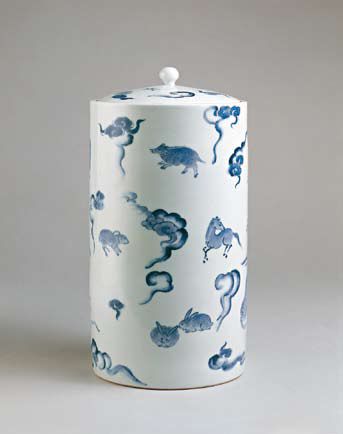
Pot à eau (mizusashi)
Porcelaine, Bleu sous couverte
Pot à eau
H. 27 x l. 14 cm
M.C. 3348
Legs, Cernuschi, Henri
This pot was wheel-thrown then shaped and decorated. The clay body is grey, heavier than that of Mino pottery although it is similar to some wares from this region, known as Mino Iga because they imitate Iga ware. Iga would therefore seem the most plausible attribution for this pot. There is a clearly visible circular mark left by a piece with which it was stacked during firing. This “kiln mark” (kamajirushi) serves to indicate either the craftsman (or workshop) or a particular commission among the batch fired in the kiln. The latter hypothesis is backed up by the discovery, on the Momoyama sites in Kyōto, of ceramics of different origins bearing the same mark. The small height of the utensil is unusual, but not exceptional..
The region of Iga, in the Mie prefecture, is very near Shigaraki, where earth from the ancient bed of Lake Biwa had been used since the 14th century to make tea jars (chatsubo). The earliest kiln in Iga is thought to have been that of Ueno Castle built by Tsutsui Sadatsugu (1562-1615), a pupil of the tea master Furuta Oribe and feudal lord of the region between 1584 and 1608. The first mention of Iga ceramics in the tea diary Tennōjiya kaiki is dated 1582. Sadatsugu’s successor Tōdō Takatora (1556-1630) continued to support this production, mainly of tea ware. The kilns probably operated until the late Kan’ei era (1624-1644). In the 1750s, new manufactories were established in Iga, but unlike the older kilns, their production was related to the increasing use of ceramics by the common people.